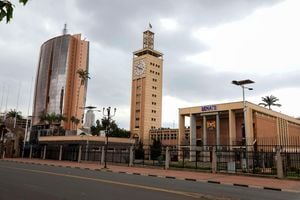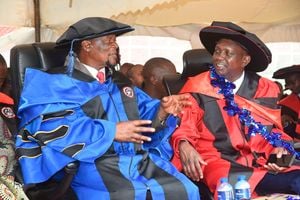How Mana Omar blazed through barriers to take Kajiado's water crisis to COP29

Mana Omar who hails from Kajiado County. She joined 70,000 delegates to the world’s biggest climate meet (COP29) in Baku, Azerbaijan.
What you need to know:
- Twenty years after watching drought destroy her father's 300 animals in Kajiado, Kenya, 29-year-old Mana Omar took her community's climate justice fight to COP29 in Azerbaijan.
- Her mission is personal - because she's witnessed girls and women in her village trading sex for water during severe droughts, while children drop out of school searching for basic necessities.
- Though she returned disappointed with COP29's meager climate finance deal, she continues to educate pastoralist communities about climate change while fighting for women's dignity and climate justice.
Two weeks ago, under the scorching Kenyan sun, Mana Omar, a determined 29-year-old woman from Kajiado County, Kenya, embarked on a life-changing journey as she packed her bags to join more than 60,000 delegates at COP29, the world's largest climate conference, held in the gleaming city of Baku, Azerbaijan.
In a soul-stirring interview with Nation.Africa, this passionate meteorology graduate opened up about the deep-rooted motivations behind her desire to attend the conference.
Mana's inspiration stems from two pivotal experiences that carved permanent marks in her soul. The first occurred when she was just nine years old, a time when her world was shattered by a relentless and merciless drought. She vividly remembers the heart-wrenching sight of her father's once-thriving herd of 300 animals — cows, goats, and sheep — succumbing to the harsh conditions that stripped her family of their only source of livelihood, leaving them drowning in despair and poverty.
The second motivation cuts even deeper; Mana spoke candidly about the harsh realities faced by women and young girls in her village, where some are forced into the unthinkable - trading sex for access to basic necessities like water. The daily struggle for survival in her community underscores the urgent need for climate action and drives her unwavering commitment to advocate for change on a global stage.
"I vividly remember that day as a child 20 years ago. The painful images of my loving father helplessly wailing next to dead carcasses of his cows, goats and sheep, wondering what was actually happening, where to restart life and what to do next. It is the kind of pain and frustration that you will never wish, even for your worst enemy. We rarely talk about the ecological or climate grief, trauma, anxiety and horrors pastoralist communities have to live with forever when climate extremes strike.
For me, climate change is also a mental health issue because as the climate crisis intensifies, many of us are feeling overwhelmed by just how much is at stake.
For younger people especially, it's hard not to feel climate anxiety when faced with drought, hunger, raging storms, extreme heat, and water shortages. Think about it, even as we continue to fight for climate solutions and a healthier future, we also need to reframe how we think of the predicament we're in.
From a tender age, I learnt that as a nine-year-old it destroys you emotionally and leaves you with many unanswered questions.
To understand what was happening, I decided to pursue meteorology for my undergraduate after passing exams and securing a government scholarship. During my research, I came across a very interesting 2017 study where the American Psychological Association (APA) drew attention to a growing state of "eco-anxiety," defining it as a chronic fear of environmental doom. Things now started making sense.
The authors noted that eco-anxiety can affect community well-being "through the loss of social identity and cohesion, hostility, violence, and interpersonal and intergroup aggression."
They were of the view that none of those consequences should come as a surprise — after all, with eco-anxiety, those affected like us are coping with not only literal loss of life, but loss of ecosystems and wildlife, collapsed infrastructure, and fewer safe places for people to live.
After graduation, I embarked on my job, which entailed observing and monitoring components of the climate system such as temperature, precipitation, air pressure and carbon cycles. But then the field work opened my eyes to a bigger problem in Kajiado.
Traditional knowledge
My people, the little common people who bear the brunt of the climate crisis the most, couldn't understand what was happening to them and why Mother Nature seemed to be furious all the time.
This does not mean that the locals do not have their own traditional knowledge and belief systems about the weather.
They primarily did not know that fossil fuels – coal, oil and gas – are by far the largest contributor to global climate change, accounting for over 75 per cent of global greenhouse gas emissions and nearly 90 per cent of all carbon dioxide emissions according to the United Nations.
This means that as greenhouse gas emissions blanket the earth, they trap the sun's heat which leads to global warming and climate change.

Mana took Kajiado's devastating story to the world stage, demanding action from global leaders.
The latest research by scientists shows that the world is now warming faster than at any point in recorded history.
This now means that warmer temperatures over time are changing weather patterns and disrupting the usual balance of nature and as a result poses many risks to human beings and all other forms of life on earth.
I, therefore, decided to quit my job so that I could dedicate my life to helping my people who are pastoralists understand what is really happening and what needs to be done using traditional music in our mother tongue, a local language they understand best.
I am now the Executive Founder and Director of a youth-led NGO known as Spring of the Arid and Semi-Arid Lands (SASAL).
We work in Kajiado and other ASAL counties on different projects with pastoralist communities and promote gender equality.
Would you believe that in 2024 in my own village and many other ASAL regions in Kenya trading sex for water is still happening?
Whenever severe drought shows up, it impacts school retention as pupils are forced to drop out of school to support their parents in the search for food, pasture, and water.
This means the girl child is exposed to sexual abuse at a very young age.
They are the girls I am trying to help so that no woman in my community is exploited like this.
A recent survey done by CARE Kenya, found that the lack of water in Kajiado makes almost half the schools opt to purchase water as they have no access to adequate water and this cripple's schools' operations.
In some of the learning institutions in Kajiado, students are asked to bring water to school.
This means they have to trek hundreds of kilometres to find it leaving children exposed to sex exploitation among other vices.
This is why I went to COP29, to be a voice for my community with hope that the global north who are the ones responsible for the pain and suffering we are grappling with pay for what they have done.
When countries signed the Paris Agreement in 2015, they decided to set a "new collective quantified goal on climate finance" (NCQG) to replace the existing goal of $100 billion per year.
The NCQG was meant to be adopted this year at COP29 in Azerbaijan, but negotiations did not go as planned. The developing world wanted $1.3 trillion to facilitate adapation and mitigation. But in the end, the west only agreed to pay 300 billion dollars. That is what we walked away with. This is not enough to cover even half of the climate challenges we face. I am disappointed by how COP29 turned out."





